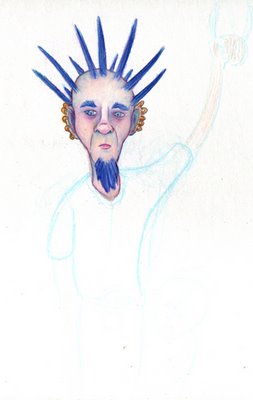
There are generally two techniques I use when prepping to draw with colored pencil. The first is described elsewhere on here (and on my Unmasked portion) using tracing paper to refine and transfer a ghost image for further drawing. Here I will describe a method I've seen on multiple occasions from cartoonists and animators hand has been used on all of my Illustration Friday (IF) colored pencil works.
I prefer to use Prismacolor pencils because of the blending quality. The only knock I have against these pencils is that sometimes in shipment they can get flexed or dropped and the 'lead' gets broken inside the pencil. When this happens and you go to sharpen them the 'lead' will just continue fall out of the wood casing. Other pencils I've tried are too hard and will not blend smoothly.

First I start with a light blue pencil to draw in the general shapes. Light blue generally does not transfer to scanners or copiers and is also used when marking mechanicals for layouts (such as magazines). In the first picture you can only see the blue lines I have darkened in heavily but in reality the entire figure is sketched in (the head has already been through the entire process and is pretty complete). Visually the light blue will disappear or can be easily blended into the other colors. When starting off with traditional graphite to rough in the shapes or leave a ghost image the problem is that the lead will often streak into your colored pencils. This will make your colors look dirty as opposed to vibrant.

This version shows the same pic with the levels adjusted so you can see the other lines.
As far as coloring as a whole...this is one method I use to help blend colors (and was used on all colored pencil drawings on my entire blog except where areas of fur are present)...I stumbled upon it the first time I used colored pencils doing a portrait because I didn't like the white patches from the tooth of the paper. I kept coloring heavier and heavier 'burnishing' the colored pencils in thickly and noticed that while doing this I could work in almost a painterly fashion blending colors. Now I use both methods depending upon the situation, as the softer touch is definitely better for a furry look.

I lay down a base color lightly.

I then go over the base color heavily with white. You can't tell a whole lot from this pic, but the white and base have started mixing and it provides a base to mix on top of...

I will then go over the arm again with the same base color or a slightly darker color. Then I will use white or a lighter color to start blending. I will finally hatch in blues or reds and use the light base color to blend again for a softer look.
This will build up a rather thick coat of color. After a while of working the area you might need to work lighter at times. If not you will start flaking off the color!
Finally, to add in details you just need a sharp colored pencil and you will be etching in to the thick layer of color you laid down.
TIPS:
This technique works best on illustration board.
Make sure to have a brush or to knock of your drawing board often as this method will leave a lot of colored fragments that can get smeared.
Have a couple of white colored pencils because you will burn a half a pencil up on a moderately size drawing.
If you are drawing 'tight refined' lines, spin your pencil after each stroke and it will help to maintain a sharp point without needing to sharpen the pencil.
After you work is complete use a fixative spray on the work. It will prevent wax bloom which can severely dull your colors.

4 comments:
I enjoy reading about your working processes and admire your patience in explaining so clearly.
As for your question I did the pen work first using indian ink, then laid in the watercolour later. But for looser styles I often do it the other way round.
funny blog and illo...thanks for visiting my blog...read you soon!!!
thanks for the great tut on CP - and prismacolor is the only way to go. and yes it stinks when they keep breaking off as you sharpen them, was wondering why that kept happening. have you tried the prisma colorless blender pencil? just got one for the heck of it
interesting techinique . thanks for sharing it.
Post a Comment